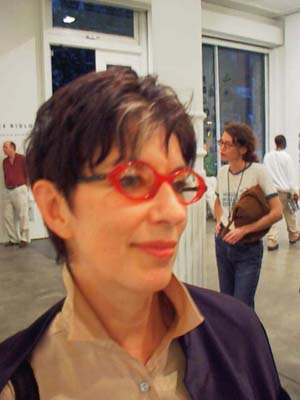
|
Re Contruction Comparative Studies . . . . . . Hilfe |
http://www.findarticles.com/cf_dls/m0268/2_38/57475773/p1/article.jhtml  Carlo Mc Cormick Art Forum, Oct, 1999, When Anne Mayhew-Young renamed herself after the official residence of the mayors of New York, she joined the likes of John Sex, Patti Astor, and Lydia Lunch, individuals who hoped that an aggressively self-conscious sense of difference could vanquish the mundane aspects of life by making the whole of it art. The East Village was a magical site for radical self-invention, where one's idiosyncratic contribution to the creative moment stood in for any actual personal history, and Gracie Mansion was the queen of the scene.  Mansion's forays into art-dealing were absurdist send-ups of the gallery establishment. In 1981, motivated by the difficulties of finding a gallery interested in her and her friends as well as by her experiences working at a So Ho? space, she hired a limousine with mail artist Buster Cleveland and Sur Rodney (Sur), her lifelong coconspirator. In the "Limo Show," the trio parked for three hours on the corner of Spring and West Broadway, where, decked out as tourists (complete with Hawaiian shirts and cameras), they served champagne and cherries to sightseers while Mansion went into her charismatically naive hard-sell spiel for anyone remotely interested. The following year her unconventional approach really reached its stride as she launched a series of exhibitions in the tiny bathroom of her tenement apartment, dubbed the Loo Division. Mansion's irreverent and populist vision of art suited for the living spaces and pocketbooks of a democratic audience not only defined the first Gracie Mansion Gallery, which opened the following spring; it also became the trademark of what would soon be celebrated as East Village art. Mansion's forays into art-dealing were absurdist send-ups of the gallery establishment. In 1981, motivated by the difficulties of finding a gallery interested in her and her friends as well as by her experiences working at a So Ho? space, she hired a limousine with mail artist Buster Cleveland and Sur Rodney (Sur), her lifelong coconspirator. In the "Limo Show," the trio parked for three hours on the corner of Spring and West Broadway, where, decked out as tourists (complete with Hawaiian shirts and cameras), they served champagne and cherries to sightseers while Mansion went into her charismatically naive hard-sell spiel for anyone remotely interested. The following year her unconventional approach really reached its stride as she launched a series of exhibitions in the tiny bathroom of her tenement apartment, dubbed the Loo Division. Mansion's irreverent and populist vision of art suited for the living spaces and pocketbooks of a democratic audience not only defined the first Gracie Mansion Gallery, which opened the following spring; it also became the trademark of what would soon be celebrated as East Village art.The success of Gracie Mansion Gallery in the mid-'80s was so phenomenal that it seemed Mansion and Sur could sell just about anything. But the key was less salesmanship than the sheer force of personality and the inspired intangibles of creativity run amok. Every show involved repainting the gallery, in some new color (but never white) and elaborate invites that were art works in themselves. From the various one-night cash-and-carry hullabaloos and the infamous "Famous Show" to any number of theme shows (such as "Sofa/Painting," in which artists created not only the paintings but the proverbial couches to match), each exhibition was a concept, an event, an installation, a party. Gracie Mansion Gallery never succumbed either to the shifting tastes and attitudes of the art world or, for that matter, to the logistics of smart business. They stuck with the silly name, improbable location, and lowbrow emotive artists long after any of it was fashionable or marketable, not because they didn't know better but because they cared more about the irrational ideal than about commerce. Today, Gracie Mansion is still the name of an exceptionally eccentric dealer and her gallery. Living in and operating a gallery out of an East Village townhouse on St. Mark's Place, Mansion still shows her friends, sells their art, and gets them reviewed. As for Sur Rodney (Sur), currently an assistant to the curator at the New School and busy documenting friends' estates for the Archive Project of Visual AIDS, he's still an active compatriot and consultant on many of Mansion's follies. And when they get together, it's still magic.  COPYRIGHT 1999 Artforum International Magazine, Inc. COPYRIGHT 2000 Gale Group More Links: http://www.alhansen.net/gracie.htm http://www.artnet.com/ag/galleryhomepage.asp?gid=697 |